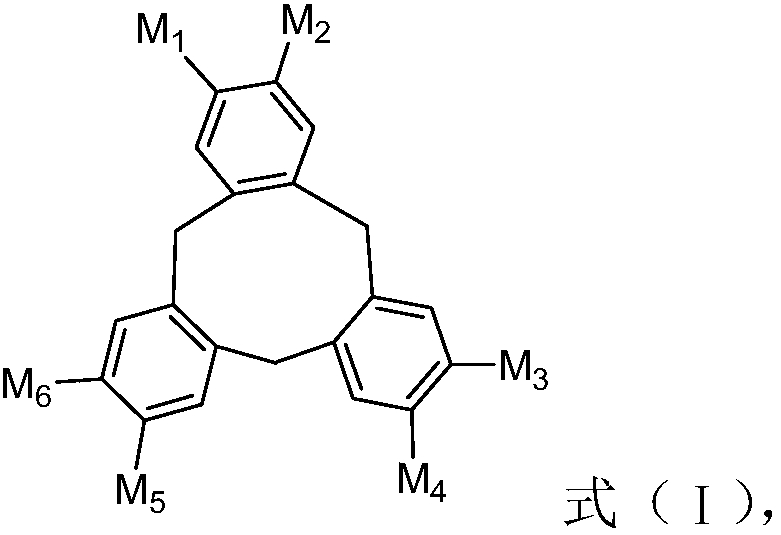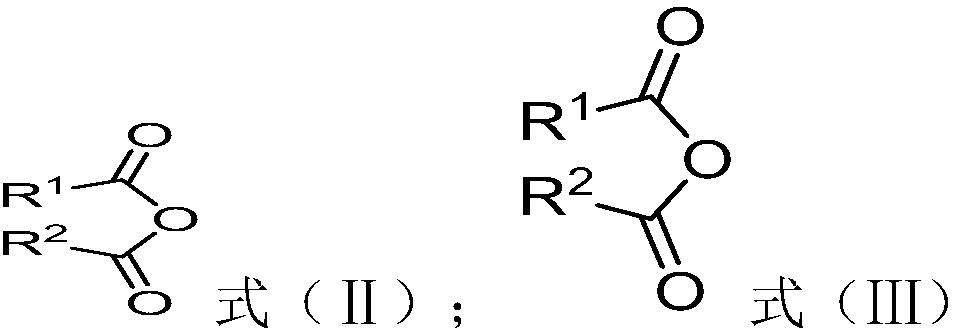Solid catalyst component and catalyst system used for olefin polymerization, and olefin polymerization method
A solid catalyst and olefin polymerization technology, applied in the field of olefin polymerization, can solve problems such as difficult to tie molecules, lack of copolymerization units, insufficient product performance, etc., to achieve the effect of improving copolymerization performance and polymerization activity
- Summary
- Abstract
- Description
- Claims
- Application Information
AI Technical Summary
Problems solved by technology
Method used
Image
Examples
Embodiment 1
[0168] (1) Preparation of solid catalyst component a
[0169] Mix 50mL of di-n-butylmagnesium in heptane (1M) with 0.1g of cyclotriveratrol (M 1 = M 2 = M 3 = M 4 = M 5 = M 6 =OCH 3 ) were mixed at room temperature, and then slowly dropped into 50 mL of titanium tetrachloride at -10°C, and kept at constant temperature for 1 hour after the addition was completed. The temperature of the system was gradually raised to 80°C, and the temperature was kept constant for 2 hours. Stirring was stopped, and the suspension was left to stand. The suspension was quickly separated into layers, and the supernatant liquid was removed, washed with toluene and hexane several times, and then dried to obtain solid catalyst component a with good fluidity. The composition is shown in Table 1.
[0170] (2) homopolymerization reaction
[0171] ① Polymerization with low hydrogen / ethylene ratio
[0172] A stainless steel reaction kettle with a volume of 2L is fully replaced by high-purity nitro...
Embodiment 2
[0188] (1) Preparation of solid catalyst component b
[0189] 4.0 grams of magnesium chloride, 50 mL of toluene, 3.0 mL of epichlorohydrin, 9 mL of tri-n-butyl phosphate, 4.4 mL of ethanol, and 0.3 g of cyclotriveratrol derivatives (M 1 = M 2 = M 3 = M 4 = M 5 = M 6 =OCH 2 CH 3 ) was added into the reaction kettle, and the reaction was carried out at a constant temperature for 2 hours under the condition that the temperature was 70°C. The system was cooled down to -10°C, 70 mL of titanium tetrachloride was slowly added dropwise, and then 5 mL of tetraethoxy silicon was added, the temperature was gradually raised to 85°C, and the temperature was kept constant for 1 hour. Stirring was stopped, and the suspension was left to stand. The suspension was quickly separated into layers, and the supernatant was extracted, washed with toluene and hexane several times, and then dried to obtain a solid catalyst component b with good fluidity. The composition is shown in Table 1.
...
Embodiment 3
[0208] (1) Preparation of solid catalyst component c
[0209]Add 4.0 g of magnesium chloride, 50 mL of toluene, 3.0 mL of epichlorohydrin, 9 mL of tri-n-butyl phosphate, and 4.4 mL of ethanol into the reaction kettle, and react for 2 hours at a temperature of 70°C. The system was cooled down to -10°C, 70 mL of titanium tetrachloride was slowly added dropwise, and then 5 mL of tetraethoxy silicon was added, the temperature was gradually raised to 85°C, and the temperature was kept constant for 1 hour. Add 0.2g cyclotriveratrol derivative (M 1 = M 3 = M 5 =OCH 3 ; 2 = M 4 = M 6 =OCH 2 CH 3 ), and continue to hold the temperature for 1 hour. Stirring was stopped, and the suspension was left to stand. The suspension was quickly separated into layers, and the supernatant was removed, washed with toluene and hexane several times, and then dried to obtain a solid catalyst component c with good fluidity. The composition is shown in Table 1.
[0210] (2) homopolymerization re...
PUM
 Login to View More
Login to View More Abstract
Description
Claims
Application Information
 Login to View More
Login to View More - R&D
- Intellectual Property
- Life Sciences
- Materials
- Tech Scout
- Unparalleled Data Quality
- Higher Quality Content
- 60% Fewer Hallucinations
Browse by: Latest US Patents, China's latest patents, Technical Efficacy Thesaurus, Application Domain, Technology Topic, Popular Technical Reports.
© 2025 PatSnap. All rights reserved.Legal|Privacy policy|Modern Slavery Act Transparency Statement|Sitemap|About US| Contact US: help@patsnap.com



